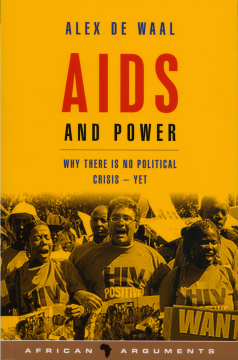
Additional Information
Book Details
Abstract
One in six adults in sub-Saharan Africa will die in their prime of AIDS. It is a stunning cataclysm, plunging life expectancy to pre-modern levels and orphaning millions of children. Yet political trauma does not grip Africa. People living with AIDS are not rioting in the streets or overthrowing governments. In fact, democratic governance is spreading. Contrary to fearful predictions, the social fabric is not being ripped apart by bands of unsocialized orphan children.
AIDS and Power explains why social and political life in Africa goes on in a remarkably normal way, and how political leaders have successfully managed the AIDS epidemic so as to overcome any threats to their power. Partly because of pervasive denial, AIDS is not a political priority for electorates, and therefore not for democratic leaders either. AIDS activists have not directly challenged the political order, instead using international networks to promote a rights-based approach to tackling the epidemic. African political systems have proven resilient in the face of AIDS's stresses, and rulers have learned to co-opt international AIDS efforts to their own political ends.
In contrast with these successes, African governments and international agencies have a sorry record of tackling the epidemic itself. AIDS and Power concludes without political incentives for HIV prevention, this failure will persist.
'In this book, Alex de Waal does what few have done before him: he moves beyond the assumed polemic, separates ideologically infused doom-saying from the available empirical evidence and bases his conclusions on what we actually know about the impact of AIDS.'
Pieter Fourie, University of Johannesburg, in Politikon
Alex de Waal is a writer and activist on African issues. He is a fellow of the Global Equity Initiative, Harvard; Director of the Social Science Research Council program on AIDS and social transformation; and a director of Justice Africa in London. In his twenty-year career, he has studied the social, political and health dimensions of famine, war, genocide and the HIV/AIDS epidemic, especially in the Horn of Africa and the Great Lakes. He has been at the forefront of mobilizing African and international responses to these problems. His books include, 'Famine that Kills: Darfur Sudan,' (1989, revised 2004), 'Famine Crimes: Politics and the Disaster Relief Industry in Africa,' (1997), 'Islamism and Its Enemies in the Horn of Africa,' (2004) and (with Julie Flint) 'Darfur: A Short History of a Long War' (Zed Books, 2005).
Table of Contents
| Section Title | Page | Action | Price |
|---|---|---|---|
| Cover\r | Cover | ||
| Contents | vii | ||
| Acknowledgements | ix | ||
| 1: A Manageable Catastrophe | 1 | ||
| Life Expectancy and Public Opinion | 5 | ||
| Structure of This Book | 8 | ||
| 2: Denial and How It Is Overcome | 11 | ||
| Private Experience and Public Concern | 11 | ||
| Giving Meaning to AIDS | 14 | ||
| ‘Normalizing’AIDS | 17 | ||
| Sex and Power | 19 | ||
| Domesticating AIDS – and Its Costs | 22 | ||
| The Media and Overcoming Denial | 27 | ||
| Pavement Radio | 32 | ||
| 3: AIDS Activists: Reformers and Revolutionaries | 34 | ||
| Confrontation and Its Limits | 34 | ||
| ‘Positive Positive Women’ | 40 | ||
| AIDS and Elections | 42 | ||
| Activist Networks, Local and Global | 46 | ||
| Transformations in Governance | 53 | ||
| New Solidarities | 61 | ||
| 4: How African Democracies Withstand AIDS | 66 | ||
| The Issue of a Lifetime | 66 | ||
| ‘Weber in Reverse’ | 69 | ||
| How Do African States ‘Really’ Function? | 76 | ||
| Democratic Demographics | 79 | ||
| The Economics of Democracy | 86 | ||
| ‘New Variant Famine’ | 89 | ||
| 5: The Political Benefits of AIDS | 94 | ||
| Ugandan Myths | 94 | ||
| ABC: Carefully Mixed Messages | 98 | ||
| ‘Fighting’AIDS | 105 | ||
| On the Difficulties of Showing Success | 108 | ||
| Treatment Regimes | 111 | ||
| 6: Power, Choices and Survival | 117 | ||
| Lutaaya, ‘Alone’ | 117 | ||
| Democracies Can Manage AIDS | 119 | ||
| Democracies Do Not Prevent HIV | 121 | ||
| Notes | 124 | ||
| Chapter 1 | 124 | ||
| Chapter 2 | 124 | ||
| Chapter 3 | 126 | ||
| Chapter 4 | 128 | ||
| Chapter 5 | 130 | ||
| Chapter 6 | 132 | ||
| Bibliography | 133 | ||
| Index | 144 |
